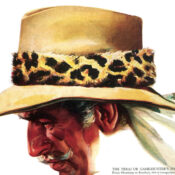 Allen B. Du Mont made television broadcasting possible when he developed a revolutionary picture tube that wouldn’t burn out in 25 hours — the tube’s previous lifespan. In 1939, he made the first consumer sale of a television set. But he realized that he’d never sell many TVs until there was regular, scheduled programming. So Du Mont launched its own television network, broadcasting live television shows and transmitting them across telephone lines to stations in 32 cities. By 1948, the Du Mont network was airing some of the country’s top shows, including The Original Amateur Hour — the American Idol of its day.
Allen B. Du Mont made television broadcasting possible when he developed a revolutionary picture tube that wouldn’t burn out in 25 hours — the tube’s previous lifespan. In 1939, he made the first consumer sale of a television set. But he realized that he’d never sell many TVs until there was regular, scheduled programming. So Du Mont launched its own television network, broadcasting live television shows and transmitting them across telephone lines to stations in 32 cities. By 1948, the Du Mont network was airing some of the country’s top shows, including The Original Amateur Hour — the American Idol of its day.
But Du Mont faced growing competition from NBC and CBS. Unlike his competitors, he didn’t have the income from a radio station to fund his television broadcasts. Then, the FCC changed the rules for allocating television channels, and Du Mont was blocked from new markets unless it broadcast in the UHF range. Meanwhile, GE and RCA were selling TV sets at a fraction of Du Mont’s price. When Du Mont went out of business in 1956, America was left with just three networks until Fox premiered in 1985.
Become a Saturday Evening Post member and enjoy unlimited access. Subscribe now




Comments
Hello,
My grandmother’s brother, a journalist and author from the 1920s-30s, wrote occasionally for the Saturday Evening Post. His name was James Vogdes Yarnall. Due to circumstances not to be covered in this note, his daughter was never able to meet him. We just love her, and we want to research so that she might be able to read something that her father had written. Where can we access anything he wrote for the Saturday Evening Post? Any help is appreciated! we have only found one thing he wrote, and it was for a nonprofit. But we heard he was quite brilliant and so we’re hoping to find something for his daughter. Thanks in advance for any help you can give us, even if it just means you’ll point us in the right direction. Best regards! PS I read the Saturday Evening Post from the earliest age i recall. Loved the covers and the content. So glad someone is continuing its mission.
Very interesting yet tragic story of a true television pioneer that never got the credit he deserved. He went out of business in 1956 along with Packard and Collier’s magazine, the latter in large part due to ad revenue losses because of TV.
Meanwhile this mid-’50s ad features a state-of-the-art American family of the time period perfectly thanks to Norman Rockwell, of course.
I have been looking for several years for a copy of The Saturday Evening Post magazine dated September 16, 1916. It has A Norman Rockwell cover, “Redhead Loves Hattie McCoy”. I do not want it for the Norman Rockwell cover, but we have a painting done by Anton Otto Fischer of a group of dogs depicting what we believe may have been a submission of this illustration for the short story titled “Snow-Blind” by Norman Duncan that we think may have been published in that issue. I have been hoping to at least find a digital copy of that issue in order to confirm this theory. Any help or information concerning this would be most appreciated. Thank you, Sula and Tom Davis. Roanoke, Virginia. 540 989 5796